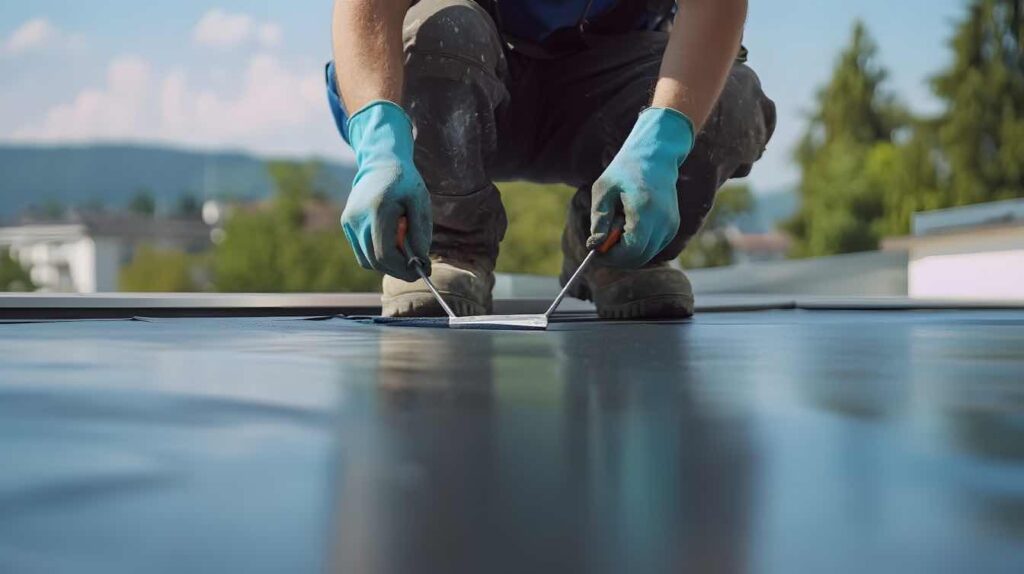Flat roofs have been around for decades, but in recent years they’ve been enjoying a surge in popularity. Sleek, modern, and versatile, they suit both minimalist new builds and stylish commercial spaces.
But before you decide a flat roof is the right fit for your project, it’s worth taking a closer look at the advantages and disadvantages. Like any roofing choice, they come with trade-offs — and knowing them in advance will help you design a roof that’s beautiful, functional, and built to last.
What is a Flat Roof?
A flat roof isn’t perfectly flat — it usually has a subtle slope, typically between 1° and 10°, so water can drain away instead of pooling.
A typical flat roof build might include:
- A structural base (timber, steel, or concrete)
- A vapour control layer to prevent condensation damage
- Thermal insulation for comfort and energy efficiency
- A waterproof membrane made from materials such as EPDM rubber, GRP fibreglass, or PVC
Different designs include:
- Warm roofs – insulation sits above the deck for better thermal performance
- Cold roofs – insulation is below the deck
- Inverted roofs – waterproofing is under the insulation for extra protection
Advantages of Flat Roofs
1. More Affordable to Build
Flat roofs are generally cheaper to construct than pitched roofs because:
- They use fewer materials
- The design is simpler
- Installation takes less time
This cost advantage can be a big plus for extensions, garage conversions, and commercial builds. Even better, a faster installation means less disruption.
2. Extra Usable Space
One of the biggest benefits of a flat roof is the extra space it provides. Instead of an unused slope, you can turn it into:
- A roof garden or green space
- A rooftop terrace for entertaining
- A base for solar panels or satellite dishes
- Equipment space for HVAC or air conditioning units
That extra area can add real value and functionality to your property.
3. Sleek, Modern Aesthetic
Flat roofs have a clean, minimalist look that works beautifully with:
- Contemporary homes
- Industrial-inspired designs
- Commercial buildings with sharp, simple lines
Architects often pair them with large windows, sliding glass doors, and skylights to create bright, open interiors.
4. Easier Access for Maintenance
Because flat roofs are level, they’re far easier and safer to walk on compared to pitched roofs. That makes:
- Cleaning gutters
- Inspecting for wear
- Repairing minor damage, simpler and often cheaper.
For commercial sites, easy access also means safer servicing for rooftop machinery.
5. Energy Efficiency Potential
Flat roofs can be excellent for energy management when designed well. They’re perfect for:
- Solar panel systems — easy to install without awkward angles
- Green roofing — plants help regulate temperature and absorb rainwater
- Reflective coatings — to keep interiors cooler in hot climates
A well-insulated flat roof can make a big difference in heating and cooling costs.
Disadvantages of Flat Roofs
1. Drainage Challenges
Even with a slight slope, flat roofs don’t shed water as quickly as pitched roofs. Standing water can lead to:
- Leaks
- Surface damage
- Structural stress
Pro tip: Install quality drainage outlets and clear debris regularly to prevent problems.
2. Shorter Lifespan for Some Materials
Older felt flat roofs might only last 10–15 years, though modern options like EPDM rubber can last up to 50 years. Exposure to sun, rain, and extreme temperatures can still shorten lifespan without proper care.
3. Temperature Swings
Flat roofs can absorb heat quickly in summer and lose it faster in winter if poorly insulated. This can make rooms underneath uncomfortable.
Fix: Choose a warm roof design with proper insulation above the deck.
4. More Frequent Maintenance
Flat roofs should be inspected more often than pitched roofs — ideally twice a year and after severe weather. Neglecting small repairs can quickly lead to bigger, more expensive issues.
Key Factors to Consider Before Choosing a Flat Roof
1. Climate
In wetter regions, good drainage is essential. In hot climates, reflective surfaces can help reduce heat absorption. Snow-prone areas may require additional structural support.
2. Material Selection
Your choice of material affects durability, cost, and maintenance. Common options include:
| Material Type | Lifespan (yrs) | Cost per m² (installed) |
| Felt (SBS modified) | 10–15 | Medium |
| EPDM Rubber | 25–50 | Medium–High |
| GRP Fibreglass | 20–30 | High |
| PVC Single-Ply | 20–30 | High |
3. Design and Functionality
Think about how you’ll use the space: will it be purely functional, or do you want a terrace or green area? Designing for your needs from the start will save costly modifications later.
How to Get the Best Out of a Flat Roof
Install a Green Roof
Besides looking fantastic, a green roof improves insulation, absorbs rainwater, and helps with noise reduction.
Add Skylights or Roof Lanterns
They flood the space below with natural light, making interiors feel larger and more inviting.
Keep Up with Inspections
Check your roof in spring and autumn, and after major storms. Small fixes early can save thousands later.
Choose the Right Contractor
Flat roofs require precision. Always hire an installer experienced with the specific material you choose and ask for a solid guarantee.
Conclusion
Flat roofs offer a winning combination of style, cost savings, and practical benefits — but they do require thoughtful design and regular care. If you invest in quality materials, proper drainage, and consistent maintenance, a flat roof can be a stylish, functional, and long-lasting part of your property.
For anyone considering a new flat roof or needing expert repairs, Weathersafe Roofing delivers the craftsmanship, professionalism, and problem-solving skills that ensure lasting results. Whether it’s tackling complex issues other companies can’t resolve or creating a flawless new installation, our team is committed to getting it right the first time.
Call Weathersafe Roofing today for your free written quotation and experience roofing done to the highest standard.

